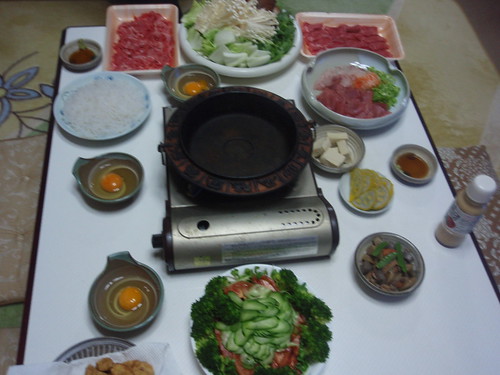I have been told many times that sukiyaki is very popular among foreigners. But, to be honest, I didn't really like it the first time I had it. I am a very picky eater, and sugar on beef was waaaay out of my comfort zone. I ate it, but I didn't think I'd repeat the experience.
Of course, there are many different ways to prepare anything. Sukiyaki is no different. The version I will be sharing here is 'Western style' which means the sauce is added as individual ingredients. The ratio is 1:1:1, so try that the first time you make it. Also, it is possible to buy already prepared sauce, my in-laws used some last time we stayed with them. This is a cook as you eat dish, so don't add all ingredients at once (unless you're preparing it on a stove to serve at one sitting.)
Here is a picture of my mother-in-law's table (kotatsu) with a lovely sukiyaki pan.
Sukiyaki
250 - 400 grams thinly sliced beef (less fat is probably better, though the expensive 'marbled' beef is best)
2 negi (Japanese leek)
1/4 Chinese cabbage
1 block yaki-dofu (fried tofu, though regular firm tofu works well, too.)
1 package konyaku noodles
1 package shimeji mushrooms
2 or 3 bunches of edible chrysanthemum (shungiku) leaves
1 Tbsp oil
3 Tbsp sake
3 Tbsp sugar
3 Tbsp soy sauce
raw egg (optional; one for each diner)
Diagonally cut negi into 2.5 inch pieces. Chop Chinese cabbage into bite-sized pieces and divide between the thicker white pieces and green leaves. Drain tofu, then cut into blocks. Boil konyaku noodles for five minutes, then drain and let cool. Cut the bottom off of mushrooms then pull into pieces of two or three mushrooms each. Trim bottoms off of shungiku, then cut into 2 inch lengths.
Heat oil in pan (you can use a regular frying pan if you don't have a sukiyaki pan.) Fry a few pieces of onion, to add flavor. Put in about 100 grams of meat and cook until almost brown. Put sugar on the beef, then add sake and soy sauce (it is better to add sake before soy sauce, so the soy sauce doesn't burn). Stir to mix sauce. Add white sections of Chinese cabbage, and more onions. Add noodles, tofu and mushrooms. Allow it to cook for a while, then add green sections of Chinese cabbage and shungiku. You may cover it to heat through, when the greens start to wither then it is ready to start digging in. Beat one egg in a small bowl, then take what you want from the pot, dip it in the egg and enjoy. Add more ingredients as needed. If the sauce seems to be decreasing, add sake.
Options:
*Mix the sauce before hand and add after frying meat.
*boneless chicken thighs
*shitake mushrooms
*leave out Chinese cabbage
In our house, we add less sugar and soy sauce than sake, to keep the sauce from becoming either too sweet or too salty. Feel free to experiment each time you make this dish.
Saturday, June 7, 2008
Sukiyaki
Subscribe to:
Post Comments (Atom)

2 comments:
I completely hear you on being mystified by the whole "foreigners like sukiyaki" idea. The first few times I tried it I couldn't get past the raw egg and I thought it was rather disgusting. Of course now I like sukiyaki a lot, so go figure. :-) I've never made it at home, though, so I'll have to try it!
i have a japanese friend and aunt. so far the thing i LOVE the most is potstickers!!!
Post a Comment